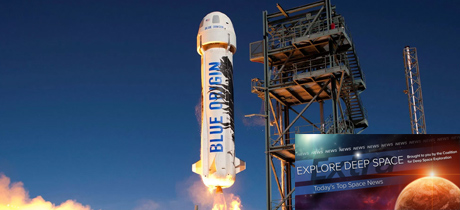In Today’s Deep Space Extra… Space exploration benefits cross the globe. Blue Origin suborbital test flight succeeds. NASA to repair Mars 2020 rover heat shield crack in time for mid-2020 launch. NASA looks to commercial space for wider role in lunar resource mission.
Human Space Exploration
Opinion: Why space exploration is relevant to the entire planet
Subscription Required
Aviation Week & Space Technology (4/27): In an op-ed, former NASA astronaut Sandra Magnus spells out examples of how investments in aerospace, and especially in space exploration and development, are providing benefits across the globe. With remote Nepal as her backdrop, Magnus finds examples in solar power systems and cell phone communications. “The trajectory for innovations used by those who live in the Langtang Valley started over 50 years ago with the decision to tackle the space frontier,” writes Magnus, a past executive director of the American Institute of Aeronautics and Astronautics. Paywall access required.
New NASA Chief mulls public-private Moon exploration
Wall Street Journal (4/29): After his first week as NASA administrator, Jim Bridenstine already is juggling starkly different visions of government versus commercial endeavors to explore the Moon. The agency sparked strong criticism from planetary scientists in recent days for canceling the most advanced publicly-financed plan for a robotic lander, dubbed Resource Prospector, intended to search for water and ice on the lunar surface.
NASA to pay more for less cargo delivery to the Space Station
Coalition Member in the News – Orbital ATK
Ars Technica (4/26): NASA’s final round of commercial resupply missions to the International Space Station reflects a cost increase, attributed primarily to a hefty SpaceX price rise, according to an audit by NASA’s inspector general. The re-supply missions are to be launched between 2020 and 2024 by SpaceX, Orbital ATK and Sierra Nevada Corp. Space X and Orbital are the current cargo mission providers. The contracts awarded by NASA in 2016 show SpaceX costs rising 50 percent, Orbital’s decreasing by 15 percent.
NASA upgrading ground stations used for emergency ISS communications
Spaceflightinsider.com (4/27): Primary communications between astronauts on the International Space Station and NASA’s Mission Control are conducted through a satellite network, the Tracking and Data Relay System. However, NASA maintains a network of ground stations that support VHF communications as a backup. That network which includes ground stations at Wallops Island, Virginia, and the NASA Armstrong Flight Research Center in California is being upgraded and equipped with more redundancy.
Space Science
NASA to replace cracked heat shield in time for Mars 2020 rover launch
Coalition Member in the News – Lockheed Martin
Spaceflightnow.com (4/28): NASA plans to replace a fractured heat shield on its Mars 2020 mission scheduled for launch in July 2020. The high priority rover mission is to include the collection and caching of Martian soil and rock samples for a future return to Earth for analysis. The damage was discovered April 12 after a test of the structure at Lockheed Martin. The company is working with NASA to determine the cause of the damage and to ensure it can be addressed with a replacement and no impact to the launch schedule.
NASA emphasizes commercial lunar lander plans with Resource Prospector cancellation
Space News (4/28): NASA is dropping plans for an agency mission called Resources Prospector, which is to seek direct evidence of ice within permanently shaded regions of craters at the Moon’s poles. Instead, NASA plans to launch key instruments on a commercial rocket and lander. A draft request for proposals was issued April 27.
NASA is reworking its Moon rover mission amid outcry from lunar advisory group
Geek Wire (4/27): The Lunar Exploration Analysis Group, a NASA chartered group of scientists, objects in a letter to new NASA Administrator Jim Bridenstine to the pending cancellation of the Resources Prospector mission, a robotic mission to explore the Moon for the presence of ice at the lunar poles, a potential resource for life support and the production of rocket propellants that could advance human exploration of the Moon.
Other News
Suborbital test flight moves Blue Origin closer to launching people
Spaceflightnow.com (4/29): Blue Origin launched a successful suborbital test flight of its New Shepard launch vehicle on Sunday. The reusable rocket and crew capsule began the 10 minute test flight to an altitude of nearly 347,485 feet with a 1:06 p.m. EDT liftoff. The crew capsule with a mannequin seated inside separated and descended to a soft landing under parachute. The launch vehicle descended under power as well. The test was the latest in a series leading to commercial passenger launches and included government and commercial payloads.
Commercial Space Office gets a boost in FAA reauthorization bill
Space.com (4/29): An FAA re-authorization measure passed by the U.S. House on Friday calls for increased budgets for the Office of Commercial Space Transportation, a regulatory body, though the bill is not an appropriation. Under the authorization, funding for the office would rise from $22.6 million in 2018 to $33 million in 2019 and $76 million in 2023, as federal agencies look to the private sector to take on more responsibility for low Earth orbit operations.
Major Space Related Activities for the Week
Major space related activities for the week of April 29 – May 5, 2018
Spacepolicyonline.com (4/28): Delayed for two years to allow for upgrading a French instrument contribution, NASA’s Mars InSight lander is scheduled to launch Saturday, May 5 at 7:05 a.m., EDT, from Vandenberg Air Force Base, California. Insight is to land on Mars in late November for first ever studies of subsurface processes. Use of a powerful United Launch Alliance (ULA) Atlas 5 launch vehicle offered NASA flexibility in choosing a West Coast launch site instead of Cape Canaveral, Florida, which is faced with a more demanding launch schedule.

